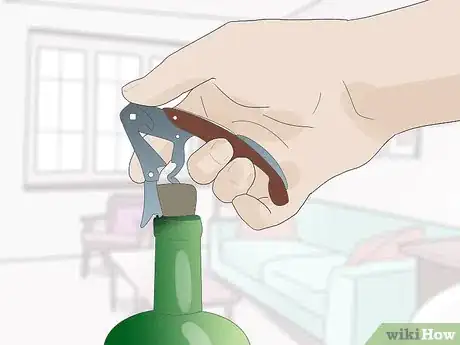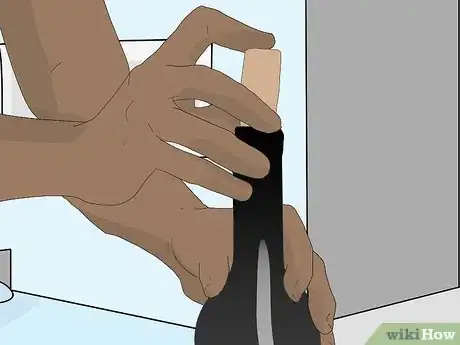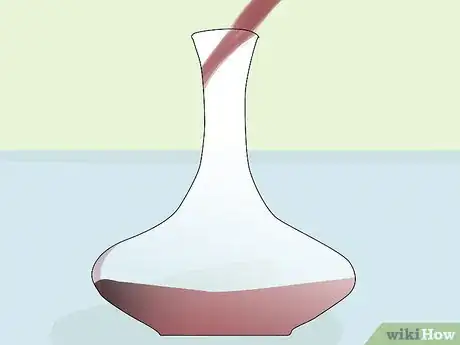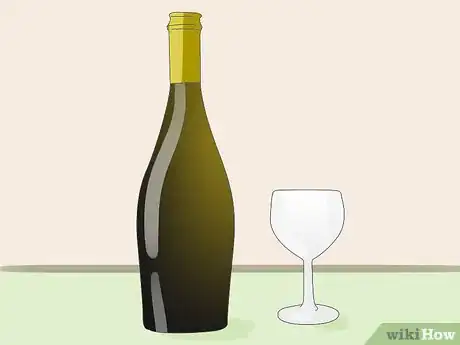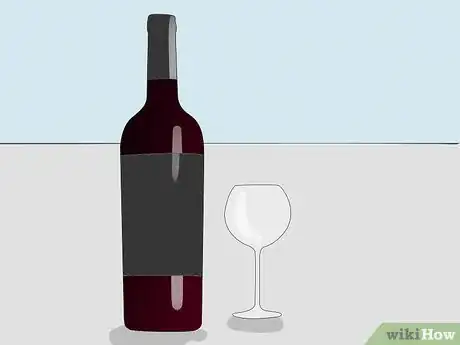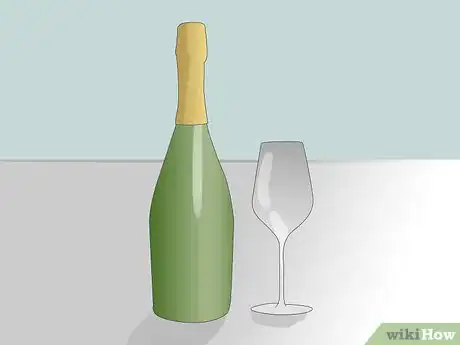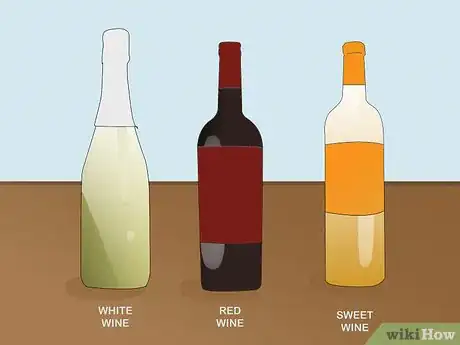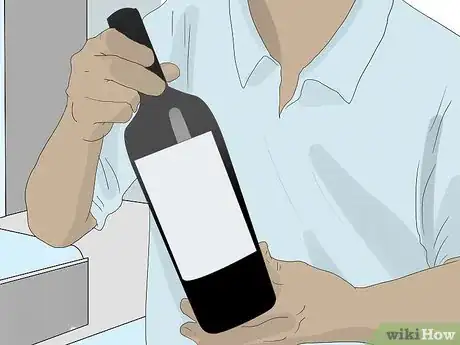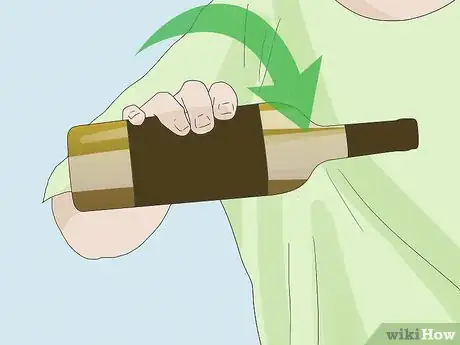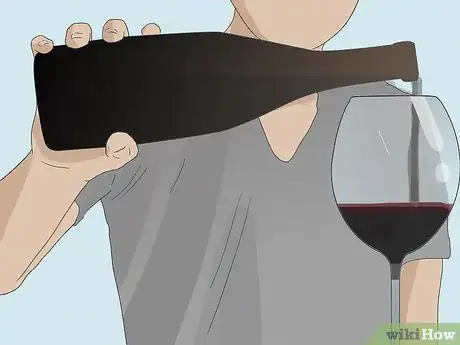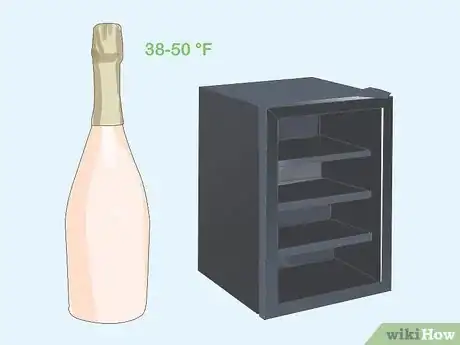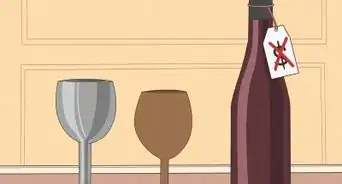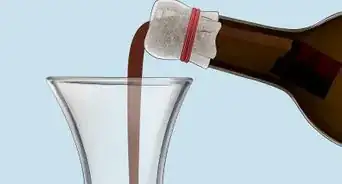This article was co-authored by Samuel Bogue and by wikiHow staff writer, Kyle Hall. Samuel Bogue is a sommelier based in San Francisco, California. He is the Wine Director of the renouned Ne Timeas Restaurant Group and a wine consultant for other top restaurants in the San Francisco Bay area. He gained his Sommelier certification in 2013, and since then has been recognized as a Zagat "30 Under 30" award winner and a Star Chefs Rising Star.
There are 8 references cited in this article, which can be found at the bottom of the page.
This article has been viewed 188,258 times.
You don't need to be a sommelier to impress people with your wine serving skills. Whether you’re having a wine night with friends or serving guests at an event, you can look like a wine connoisseur by following some simple serving tips. Remember that reds, whites, and sparkling wines are all served differently, and you'll need to chill them at different temperatures so they taste right. Also, make sure you're using the right glass for the type of wine you're serving. Don't forget a corkscrew!
Things You Should Know
- After opening a bottle, re-cork it so that the wine stays fresh longer, and decant red wines that are 5 years old or more.
- Serve white wine in small-bowled glasses, red wine in large-bowled glasses, and sparkling wine in tall, thin glasses.
- Serve white wine first, followed by red and sweet wines, and pour it in a swift, steady motion until the wine glass has 5-6 ounces of wine.
Steps
Opening the Wines
-
1Cut the foil off the lip on each bottle of wine with a foil cutter. The lip is the raised rim at the top of the bottle. Position the foil cutter so it’s resting on the top of the lip and squeeze it to cut the foil that’s covering the cork.[1]
- You can find a foil cutter online or at your local wine store.
-
2Uncork the wines with a corkscrew. Position the tip of the corkscrew on the cork so it’s a little off center. Push down and turn the corkscrew. Keep turning until you’re one turn away from the corkscrew being all the way inside of the cork. Then, pull up on the handle of the corkscrew with your fingers until the cork pops out of the bottle. Repeat on all the bottles of wine you’re serving.[2]
- If you do not have a corkscrew, you can open the wine bottle using sommelier knife, a screw and pliers, or even a shoe.
Advertisement -
3Re-cork opened bottles so they stay fresh. Insert the wine-stained side of the cork back into the bottle after you've poured some of the wine into a glass. Store the wines in the fridge when you're not drinking them. The cold temperature will slow down the rate at which the wines go bad.[3]
-
4Decant red wines that are 5 years or older. After 5 years, bottles of red wine can develop bitter-tasting sediment. Decanting separates the wine from the sediment. After you open the bottle of red wine, slowly pour the wine into a wine decanter. When you get to the last bit of wine in the bottle, carefully observe the inside of the neck of the bottle. When you see sediment start to accumulate on the neck, stop pouring.[4]
- Pour your guests wine using the decanter. When the decanter is completely empty, refill it with another bottle of red wine.
Choosing Wine Glasses
-
1Serve white wines in small-bowled glasses. The bowl is the part of the glass the wine sits in. Serve light-bodied white wines, like Moscato and Soave, in wine glasses with bowls that are tall and thin. Full-bodied whites, like Viognier, should be served in wine glasses with shorter, rounder bowls.[5]
-
2Serve red wines in large-bowled glasses. The wider opening of the bowls in red wine glasses makes the wine taste smoother. Full-bodied red wines, like Cabernet Sauvignon, should be served in tall, large red wine glasses. Serve low-bodied reds, like Pinot Noir and Gamay, in a shorter glass with a slightly rounder bowl.[6]
-
3Use tall and thin glasses for sparkling wines. Sparkling wine glasses have a thin bowl with a small opening. They’re thinner and more tapered at the base than white wine glasses.[7]
Pouring the Wines
-
1Serve white wines first, followed by reds and sweet wines. After serving your light-bodied whites, like Pinot Grigio and Asti, move on to full-bodied whites, like Chardonnay and Viognier. Then transition into your reds, starting with light-bodied red wines, like Lambrusco, and finishing with full-bodied red wines, like Barolo. Save sweet wines, like Sauternes and Vintage Port, for last.[8]
-
2Hold the wine bottle so the label is facing out. This is just a courtesy so people can see what kind of wine you’re serving them.[9]
-
3Hold the bottle by the body with your dominant hand. The body is the wide base of the bottle. Firmly grasp the body with your fingers so the bottle is secure in your hand. Place a wine glass on a flat surface in front of you.[10]
-
4Turn the bottle horizontally to start pouring. The neck and lip of the bottle should be hovering about 1 inch (2.5 cm) above the rim of the wine glass you’re pouring the wine into. Don’t rest the neck on the rim of the glass. The side of the wine bottle should be parallel with the surface the wine glass is on.[11]
-
5Pour with a swift, steady motion. Don’t hesitate or pour too slowly or wine will drip down the side of the bottle. Avoid moving or tipping the bottle when you’re pouring to prevent wine from splashing out of the glass.[12]
-
6Fill the glass with 5-6 ounces (148-177 mL) of wine. Never fill wine glasses all the way up to the rim (it's OK if the foam comes up to the rim of the glass when you're pouring sparkling wines). Carefully watch the level of wine as you're pouring so you know when to stop.
- If you’re not sure what 5-6 ounces (148-177 mL) looks like, learn using a measuring cup. Before your guests arrive, practice filling a measuring cup with the right amount of wine and then transferring it to a wine glass. Memorize where the wine comes up to on each kind of wine glass so you know when to stop pouring.[13]
-
7Turn the bottle back into an upright position. Be swift and steady. Don’t lift the neck of the bottle too slowly or wine will drip everywhere.
- Hold a napkin in your hand while you're pouring so you can catch any droplets with it when you lift up the bottle.
-
8Chat with your guests and be mindful about refilling their glasses. If you see someone's glass is low, offer to pour them more wine. Tell your guests about the wines you're serving them. Let them know what kind of wines they are, how old each bottle is, and where they all came from.
Chilling the Wines
-
1Chill red wine to 53-69 °F (12-21 °C). Always serve red wine below room temperature. Serve rich red wines, like Cabernet Sauvignon and Shiraz, at a warmer temperature than light red wines, like Pinot Noir and Zinfandel. Rich wines taste smoother when you serve them a little warmer.[14]
- If you don’t have a wine cooler, chill the red wine in the refrigerator for 30 minutes before serving. Only chill rich red wines, like Merlot and Rioja, for 15-20 minutes in the fridge since they taste better warmer.
- If you're chilling wine in the fridge, turn the temperature dial up 1 or 2 notches so the wine doesn't get too cold. Don't forget to turn it back after you're done chilling the wine.[15]
-
2Serve white wine when it’s 44-57 °F (7-14 °C). Serve light, zesty white wines, like Chablis and Grenache Blanc, at the lower end of the temperature spectrum — 50 °F (10 °C) or colder — and oak-aged white wines at the higher end. Use a refrigerator to chill white wine if you don’t have a wine cooler. Place the wine in the fridge several hours before serving.[16]
- Turn the temperature dial up 1 or 2 notches in the fridge when you're chilling wine. Regular fridge temperatures can make wines too cold.[17]
-
3Chill sparkling wine in the freezer. Place it in the freezer one hour before serving so it reaches a temperature between 38-50 °F (5-10 °C). Expensive sparkling wines can be served at 50-55 °F (10-13 °C). Chill these wines in the refrigerator for a few hours before serving, like you would with white wines.[18]
Expert Q&A
Did you know you can get expert answers for this article?
Unlock expert answers by supporting wikiHow
-
QuestionHow should you serve wine correctly?
 Samuel BogueSamuel Bogue is a sommelier based in San Francisco, California. He is the Wine Director of the renouned Ne Timeas Restaurant Group and a wine consultant for other top restaurants in the San Francisco Bay area. He gained his Sommelier certification in 2013, and since then has been recognized as a Zagat "30 Under 30" award winner and a Star Chefs Rising Star.
Samuel BogueSamuel Bogue is a sommelier based in San Francisco, California. He is the Wine Director of the renouned Ne Timeas Restaurant Group and a wine consultant for other top restaurants in the San Francisco Bay area. He gained his Sommelier certification in 2013, and since then has been recognized as a Zagat "30 Under 30" award winner and a Star Chefs Rising Star.
Sommelier & Wine Consultant
-
QuestionShould a man pour wine for a lady?
 Community AnswerYes, unless she would prefer to pour her own.
Community AnswerYes, unless she would prefer to pour her own. -
QuestionWhich hand should I use to hold the bottle?
 Todd FriendCommunity AnswerUse your right hand always.
Todd FriendCommunity AnswerUse your right hand always.
References
- ↑ https://winefolly.com/tips/basics-serving-wine-glassware/
- ↑ https://www.tastingtable.com/drinks/national/how-to-pour-wine-how-to-open-a-bottle-of-wine
- ↑ http://www.winemag.com/2015/05/15/5-tips-for-storing-opened-wine/
- ↑ http://www.winespectator.com/webfeature/show/id/how-to-serve-wine-decanting
- ↑ http://winefolly.com/tutorial/the-importance-of-a-proper-wine-glass/
- ↑ http://winefolly.com/tutorial/how-to-pour-wine/
- ↑ http://winefolly.com/tutorial/how-to-pour-wine/
- ↑ http://blog.vinfolio.com/2017/02/07/best-order-to-serve-wine-at-a-party/
- ↑ https://www.tastingtable.com/drinks/national/how-to-pour-wine-how-to-open-a-bottle-of-wine
- ↑ http://winefolly.com/tutorial/how-to-pour-wine/
- ↑ http://winefolly.com/tutorial/how-to-pour-wine/
- ↑ http://winefolly.com/tutorial/how-to-pour-wine/
- ↑ http://winefolly.com/tutorial/how-to-pour-wine/
- ↑ https://winefolly.com/tips/basics-serving-wine-glassware/
- ↑ http://nymag.com/restaurants/articles/wine/essentials/temperatures.htm
- ↑ https://winefolly.com/tips/basics-serving-wine-glassware/
- ↑ http://nymag.com/restaurants/articles/wine/essentials/temperatures.htm
- ↑ https://winefolly.com/tips/basics-serving-wine-glassware/
About This Article
To serve wines, chill red wines between 53 to 69 °F, served in a large-bowled glass, and white wines between 44 to 57 °F, served in a small-bowled glass. When you’re ready to pour, cut the foil off of the lip of bottle, and uncork the wine with a corkscrew. Hold the bottle in your dominant hand with the label facing outward, and tilt it horizontally to start pouring. Keep the neck and lip 1 inch above the rim and hold the bottle steady. Fill the glass with 5 to 6 ounces of wine, paying attention to the glass as you pour. For more tips, including how to choose the right wine glass for your type of wine, read on!

